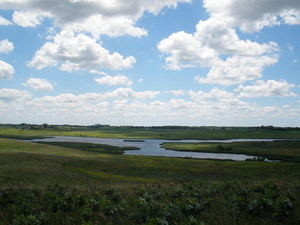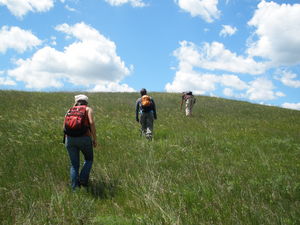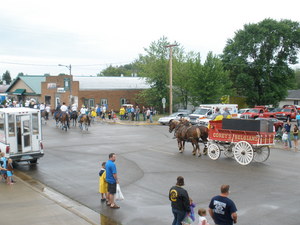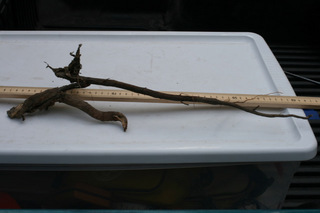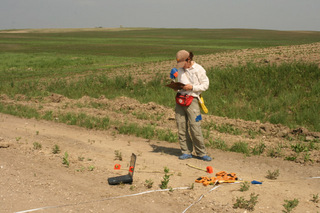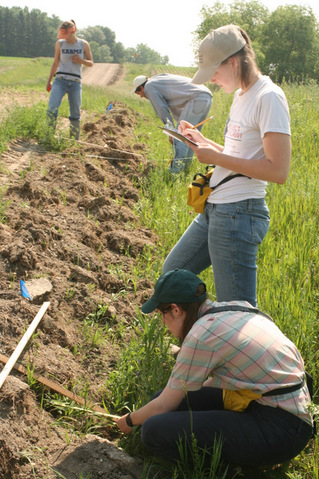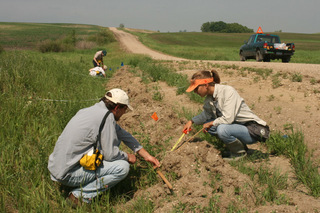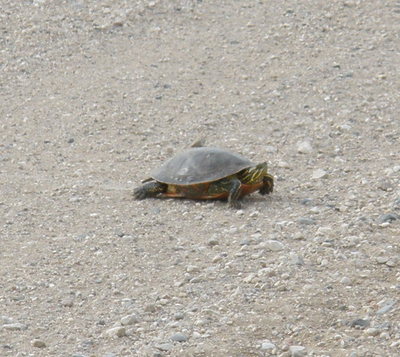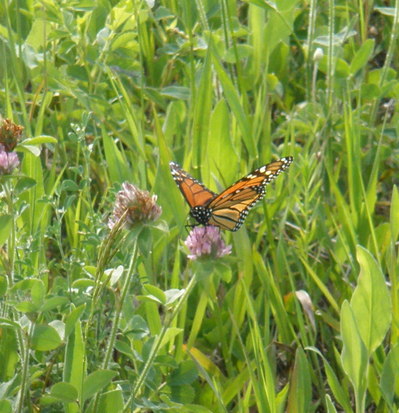|
|
You know you could barely contain yourself with all the excitement and anticipation … here are the handles revealed!
Allegra- Legos
Amanda- Robo Cop
Amy- Joker
Caroline- Riddler
Daniel- Yea Mon
Greg- GT
Gretel- Queen Bee
Kate- Monster
Mimi- Penguin
Stuart- Drone
Hello everyone,
I’m glad you are all going to visit, neighbors. The echinacea is about to flower in full force, as are the leadplant (not today but soon), coreopsis in abundance, some goldenrod, purple prairie clover, dalea. Additionally galium, phlox, alumroot, ground cherries and lilies are blooming.
There will be many pollinator neighbors out next week trying to make a speedy delivery. If the weather is nice Mon AM, why don’t you join us, neighbor?
See you all Mon.!
In an attempt to outflog the rest of the team, I will describe what we did today. In the morning, most of us collected data for the phenology exp. No new plants had flowered, but some mistakes were caught in the flagging of positions from yesterday. I saw one of the large Halictid bees going to town on one of the flowering heads.Then until about 1, most of us headed out to the landfill site with different tasks in mind. I needed to do a test run of the FNC (I get tired of writing out floral neighborhood characterization) to see what obstacles we are going to face and about how long each one will take. Amanda helped me ID plants and test out the general protocol and it took about five minutes but there only 4 co-flowering species–Amorpha canascens, toothed evening primrose, Phlox pilosa, and Northern Bedstraw. Some species are more difficult to quantify in terms of number, such as Galium. After some discussion with Stuart, I think we will probably count each inflorescence as 1 “unit” so that counting the number of co-flowering species will be systematic and consistent. And now for more pretty pictures: 

Above: Glacial Lakes State Park trip, only a half hr away!

A plant we couldn’t ID. Help?


Old Runestone Day Parade pics, Per & Hattie the candy gatherers
Team Echinacea had a busy week last week.
We finished seedling searches in the remnants.
We found ~22 spittle bugs masses in the CG.
We talked a lot about plans for many projects and started organizing and practicing.
We ordered supplies.
On Thursday afternoon we pulled and cut thistles in the CG.
We started and finished the “recruitment experiment.” This experiment started off as the “recruitment experiment.” I hand broadcast seeds in fall ’00, ’01, and ’02 in plots with different burn treatments. Now we are assessing plant survival. (We need a better name for this experiment.) Last year there were over 820 plants alive. After a quick scan of the datasheets, I think 9 plants will flower this year. Wow, much less than 1%! These plants are taking a long time to flower. After entering data, Amy will give a detailed summary of our findings this year. Notes for next year: improve datasheets for entering fl pla info, avoid searching at empty spots, & map plants using tripod system.
On Friday the first plant in the CG started to flower — one floret started male phase. We saw the pollen. No plants started on Saturday and on Sunday 3 plants started to flower.
So, *drum roll please*
Here are the possible candidates for the remnants that I will be looking at this summer.
In no particular order, I will pick 7 out of:
KJs
NW of Landfill
Landfill
Krusemark
East of Town Hall
Aanenson
Randt
Yellow Orchard Hill
Nessman
Depending on what Amy needs for her seedling searches, I can adjust accordingly, but these sites should give a good cross-section of isolated prairie remnants and well populated ones. Tomorrow, we will spend another hour searching for spittlebugs in the common garden, and hopefully enough will be found for a sufficient sample size. Phenology has also started in the common garden, and we have 4 plants that are flowering so far, with hopefully more by tomorrow.
We went out to the Glacial Lakes reserve today for a hike, and it was incredibly beautiful. We took lunch and hiked all afternoon, seeing some flowering Echinacea, noticing a bumblebee on one of the flowering Echinacea, and stopping every 5 minutes to look at a new plant. We even did a few seedling searches! (Stuart has trained us well….)
We finished searching for seedlings at the last site (Staffanson Prairie Preserve) on Monday. All the datasheets & maps (163 pages) are now organized in a 3-ring binder.
Here are a few highlights:
We found total of …
> 22+1+5+1+8+2+24+4+13+0+5+7+1+0
[1] 93
… ninety-three seedlings at fourteen sites!
In August we’ll go back and check the fate of every one of those seedlings. I hope we can find them all!

Mimi, Amanda, Greg, Allegra, Daniel, Caroline, and Gretel
looking for seedlings on the scraped roadside at Riley’s site.
(They didn’t find any here.)
Two possible Echinacea seedlings (not counted above) were noted. We should go back to check their identity within the next week. At site NWLF we left a pin flag at focal plant #13073. At site ERI the possible Echinacea seedling was at R102 (see page 97). Help me remember to check these!
We found about 500 other Echinacea plants within the circles, mostly juvenile plants and some adults (flowering and not).
> 16+16+25+131+63+33+73+24+46+5+16+46+6+11
[1] 511
The roadsides at sites ER and ERI were scraped. In the area that was scraped, all the tags are gone. We did see many little Echinacea leaves peeking through the gravel, but no seedlings. In some areas the scraping was deeper and some roots of old plants were pulled out. I collected one pulled root from the S side of the road on the W half of RI; I couldn’t tell from where it was yanked. 
The root was huge!
With our very precise maps of plants from previous years, we will be able to identify which plants are gone and which persist. It will be a challenge though. In some dense areas we may not be able to figure it out. Stay tuned, we’ll bring the detailed maps and try to figure it all out in August, after peak flowering.

Gretel determining the identity of individual Echinacea plants
at the scraped roadside at Riley’s.
The scraped gravel was piled in the ditches. Some plants in the ditches were buried and I expect that many of them will die. There will probably be a lot of weeds in and around those piles for the next few years (until the perennials take over again). 
Two images (above & below) of the piles of gravel deposited
in the ditch on the S side of the road at Riley’s.

Another highlight (no photos though):
It was a pleasure to visit Staffanson. Gretel and I mapped the focal locations on Sunday and saw a patch of Cypripedium calceolus in flower (past prime). Almost every focal plant in the West unit (unburned) had spittlebug spittle on it. Almost none of the focal plants in the East unit (burned) had spit.
We didn’t use the tripod to take photos. The camera didn’t attach well and the remotetrip feature isn’t ready yet. We’ll need to work on the tripod and practice using it. I think it holds great potential to speed up and improve our protocol.


Those are just 2 of the many cool encounters I had yesterday on my bike ride past Hegg Lake and through Runestone Park. I also saw: pelicans, an American egret, a hare, tons of red-winged blackbirds and many other birds I can’t yet identify, a wild turkey, a skink, and lots of interesting pollinators. I also saw some flowering Echinacea along the side of the road…I think Stuart probably knows about them (?) but I didn’t see any tags and there ones that had flowered last year as well.
I thought I’d also flog the decisions we’d made last week about chores. The tasks are:
>sweep daily: G3–Mimi, the front porch–Allegra, and inside–Gretel
>clean the table tops and put away chairs daily–Amanda
>organize the bins and flags in G3 daily–Daniel
>shake out the rugs once a week–Amanda
>clean the bathroom once a week–?
-Mimi
Here’s my proposal for my project. Read it. Savor it. Constructively criticize it.
jenkins echinacea proposal.doc
It’s still very helter-skelter at this point and in need of much fine-tuning, so any suggestions are greatly appreciated. Thanks!
Also, I’ll re-attach the docx files from my last post in doc format.
Echinacea Pollinators nesting2.doc
Protocol for Taking Pictures of Insect Specimens.doc
On a side note, yesterday was a really exciting day because I found my first seedling, we got two bikes at a garage sale for $25 each, and there were the Runestone Days fireworks in the evening. The party lasted long into the night in K-town, and I think I remember falling asleep to the sweet sounds of AC/DC You shook me all night long coming from the street dance. These folks know how to party. I’m looking forward to the kiddie parade tomorrow! Although Amanda and I were saddened to hear it wouldn’t be a kitty parade.
My name is Allegra Halverson and I am from New Hampshire. I am an undergraduate student in Botanical Science at McGill University in Montreal, and a recent addition to Team Echinacea. Lots of things happened this week, so here are a few highlights:
We moved into the old town hall and I’ve been loving the bike ride to the farm in the mornings so everyone with access to a bike should bring it!
I saw a garter snake, two frogs, two deer, ground squirrels, a wild turkey and lots of birds.
Gretel and I selfed Megan J’s prairie turnip plants at the landfill site on Wednesday. We also helped Andrea put out flags and fungal traps in the CG for her mycorrhizae project.
I started my plant collection at the landfill and common garden with 15 plants so far. I have to make a plant collection for a class next winter and will also make one for the Echinacea project at the same time to help future newbies with plant identification.
During this first week we received a lot of background information on the project and began the planning stages of our own projects related to the larger questions about Echinacea in the fragmented prairie habitat. Several projects surrounding the question of competition for pollinators were chosen along with pollen identification projects and one project about the aphids. My project will focus on how inter-specific pollen landing on Echinacea flowers effects style persistence. pollen competition proposal.doc
We developed a new key for the labeling seedling search maps:
-each plant in the circle has a dot with line drawn to the center and the distance (cm) to the focal plant written on the line
s with a circle around it: a seedling
B with a circle around it: a basal plant, not flowering
* with a circle around it: a flowering plant, should have a metal tag like this 7819.2 (.2 is the number of flowering heads)
N with a circle around it: a nail with a metal tag on it
any plot with a plant found in it, other than the focal plant, had a map made for it.
any plot with a seedling found in it was photographed and a pencil marker with a letter (for basal or seedlings) or number (for numbered plants) was placed 2 cm west of all plants
a toothpick was placed 5 cm from the seedling towards the focal plant
am i missing anything?
I should introduce myself to the new Team – I’m Ruth Shaw. I’ve collaborated with Stuart and the Team on this project since 2000. I’m a professor at the University of Minnesota in the Department of Ecology, Evolution and Behavior. Broadly speaking, my research addresses questions about ongoing evolution in plant populations, and I have found this project on the evolutionary consequences of fragmentation of populations of Echinacea endlessly stimulating!
I’m just back from the joint meeting of the Society for the Study of Evolution, The American Society of Naturalists, and the Society of Systematic Biology, where I gave a brief talk about some of our results based on 7-years of data on “Inb1” an experiment to compare the effects of inbreeding and of crossing between remnants. This experiment has been growing in the common garden since 2000, and we have now documented that the degree of inbreeding depression is exceptional, far exceeding that found in other studies. Intriguingly, we have also found that both inbreds and progeny of between remnant crosses harbor more of the specialist aphid than plants derived by random mating within remnants.
A special highlight of the meeting is that our paper about estimating fitness, with examples (available via the main echinacea website), received the President’s Award, chosen by the current President of ASN as outstanding paper of 2008 in the journal, The American Naturalist. Quite an honor!
I was out in Douglas County in late May for the early monitoring of seedling recruitment in the remnants, and I’m glad to hear that process is moving forward well! I’m looking forward to getting back out there and working with you all soon!
|
|

